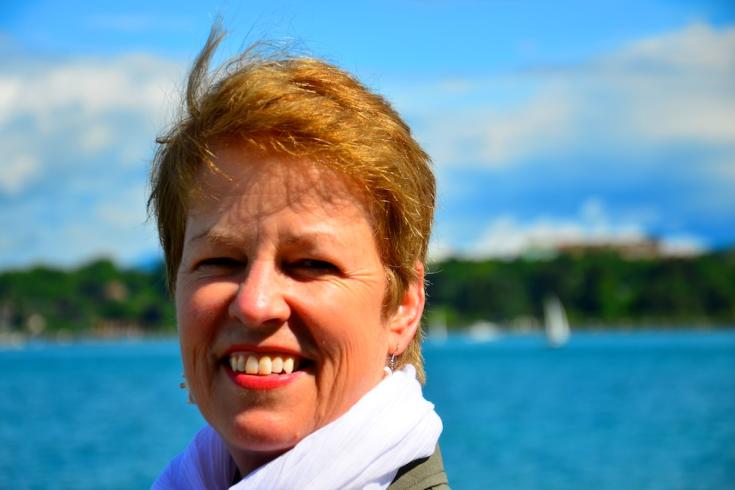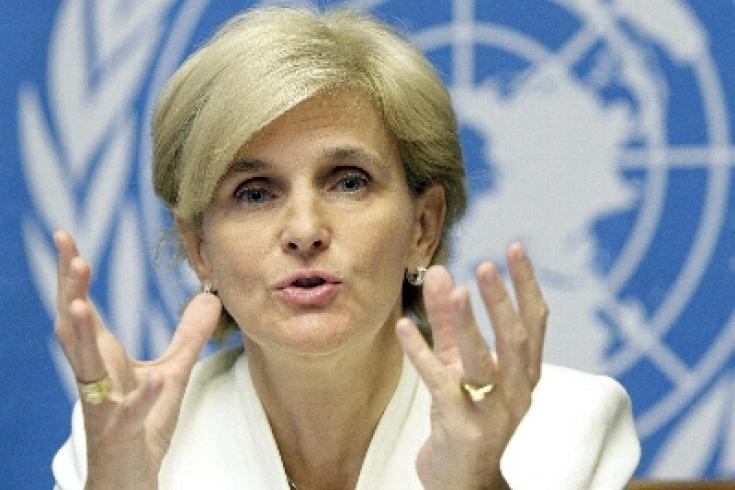One year after FukushimaThe CTBTO's contributions
This event is part of the Tim Hampton Lecture Series, in commemoration of one of our most beloved and dedicated staff members. Tim was always willing to enthusiastically share all the knowledge he had, with anyone and everyone.
Colloquium on 9 March 2012
Participating organizations included the Japanese Permanent Mission to the United Nations in Vienna, the International Atomic Energy Agency (IAEA), the Intergovernmental Oceanographic Commission (IOC) of the United Nations Educational, Scientific and Cultural Organization (UNESCO), the United Nations Scientific Committee on the Effects of Atomic Radiation (UNSCEAR), the World Health Organization (WHO) and the Austrian Permanent Mission to the World Meteorological Organization (WMO).
CTBTO Spokesperson Annika Thunborg moderated the colloquium: "This event is part of the Tim Hampton Lecture Series, in commemoration of one of our most beloved and dedicated staff members," she explained. "This is a series of informational lectures concerning various technical topics related to the CTBTO. Why name this lecture series after Tim Hampton? Let me say that Tim was always willing to enthusiastically share all the knowledge he had, with anyone and everyone. We hope that these lectures would be a clear demonstration of the enthusiasm, joy and inclusiveness which Tim showed us every day," Thunborg said. SESSION 1 - INTRODUCTION AND INTERNATIONAL COOPERATION Click image to see video of each presentation.
Video: CTBTO's Global Warning Systems and Emergency Response
Introduction and significance
The CTBTO’s International Monitoring System (IMS) can contribute to the mitigation of disasters in several ways: it can provide time-critical data for disaster early warning, for measuring radioactivity in the atmosphere after nuclear accidents, and for broadening the scientific knowledge basis about such disasters. Besides providing such data, it is equally important to assure its best use through a coordinated and coherent UN response.
Lassina Zerbo, Director of the International Data Centre
Fukushima taught us how crucially important it is to share information with other international organizations and States Parties.
Japanese perspective
“Through the timely provision of concrete data on the concentration levels of radioactive materials and through its science-based predictions of the dispersion of the radiation plume, the CTBTO showed to the Member States that the concentration levels of the radioactive materials were far below levels that could cause harm to human health.” Japan has provided a voluntary contribution of over US$ 730,000 to further enhance the CTBTO’s capabilities to track airborne radioactivity through Atmospheric Transport Modelling (ATM).
Ambassador Toshiro Ozawa, Permanent Representative of Japan to the United Nations in Vienna
Japan appreciates the contribution of the CTBTO and sincerely thanks its staff for their dedicated work during these difficult times.
IAEA perspective
Fukushima had “collateral benefits” for the scientific community and for all of us, because it brought us much closer together and gave us the opportunity to work closer with the CTBTO and other organizations. The CTBTO data was made available to the IAEA within the first hour of the accident, and it is now available on a permanent basis to the agency. The IAEA’s Fukushima Monitoring database contains more than 1 million data measurements from different sources.
Denis Flory, IAEA Deputy Director General and Head of the Department of Nuclear Safety and Security
UNESCO/IOC perspective
CTBTO and IOC-UNESCO have enjoyed fruitful collaboration since 2005, which was formalized through an agreement in 2010. The seismic data from the CTBTO’s International Monitoring System is provided with very high reliability and quality, both of which are essential for accurate tsunami warnings, including for avoiding unnecessary evacuations.

Wendy Watson-Wright, Executive Secretary of IOC-UNESCO
UNSCEAR perspective
All UN organizations have to work closely together in order to provide timely and precise information when responding to disasters such as the Fukushima accident. The CTBTO network, which proved invaluable in the first two weeks after the accident, is a unique source of data not only in crisis situations but is also of great long-term importance for scientific research: “Science can profit from your data and you can profit from science.”
Wolfgang Weiss, UNSCEAR Chair
WHO perspective
The importance of inter-organizational and inter-sectorial collaboration is one of the most critical lessons learned from the Fukushima disaster. CTBTO data proved crucial in enabling the WHO to provide accurate information to the public on health issues after the nuclear accident: “We would like to thank CTBTO for the collaboration, openness and providing data.”

Maria Neira, Director of the Department of Health and Environment at the WHO
WMO perspective
CTBTO data were very important for the WMO to provide timely and accurate estimates of radioactive releases. The fact that the CTBTO monitoring network is technically completely independent is a crucial advantage in emergency situations: “During the Fukushima crisis, the system was very reliable and stable and able to monitor the dispersion of radionuclides all over the globe.”
Michael Staudinger, Permanent Representative of Austria to the WMO
CTBTO response
The Fukushima crisis was an unprecedented “stress test” for the CTBTO monitoring system. We need to be ready for similar complex disasters in the future. The CTBTO was able to provide data on radioactive dispersion in a timely manner only because of the investments undertaken by the international community. “But all of us can make a better return on this investment if we learn the lessons from the past and if we get better prepared for the future.” See also Tibor Tóth's remarks (PDF) at the Commemoration Ceremony of the Great Japan Earthquake on 12 March 2012 in Vienna, Austria.
CTBTO Executive Secretary Tibor Tóth
We need complex systems to respond to complex disasters. And that’s exactly what the CTBTO International Monitoring System is.
Overview and concepts
Most of the around 270 monitoring stations established at the time recorded the 11 March event.
Seismic analysis of the Tohoku Earthquake
The 11 March Tohoku earthquake was the fourth-largest since 1900, the area of rupture extending over 100 kilometres. It was recorded by each of the CTBTO’s 140 seismic stations operative at the time. In the following months, approximately 10,000 aftershocks were detected, 800 on 11 March alone. CTBTO seismic data, provided in real time to authorities in Japan and other countries bordering the Pacific, contributed to tsunami warnings after the Tohoku earthquake.
CTBTO seismic stations detected 44,761 seismic events in 2011.
Accurate Event Locations using Regional Observations
The travel time of a seismic wave can differ significantly depending on regional characteristics of the Earth’s crust. In close cooperation with some of its scientifically more advanced Member States, the CTBTO has undertaken an initiative to re-calibrate its seismic network by taking such regional particularities into account. This will considerably enhance the CTBTO’s ability to locate nuclear explosions and benefit seismic hazard studies.
A better understanding of local seismic travel times will allow to better pinpoint the signal’s source.
Hydroacoustic data from the Tohoku Earthquake
The Tohoku earthquake was recorded by the CTBTO hydroacoustic station on Wake Island (USA) and forwarded to tsunami warning centres. The station, which was left intact, recorded both the rupture of the Earth’s crust and the tsunami wave as it passed over the station. The CTBTO’s high-precision hydroacoustic data have more untapped potential uses for disaster warning.
Pressure signal of the Tohoku tsunami wave passing over Wake Island hydroacoustic station.
From Tohoko Earthquake to Civil Applications using Infrasound
Seven CTBTO infrasound stations detected sound waves generated by the ground vibrating during the Tohoku earthquake. The subsequent explosions of the reactor building at the Fukushima power plant were also recorded. Other potential applications of infrasound data include the monitoring of volcanic eruptions to warn civil aviation, and studies of storm systems and the atmosphere.
Infrasound stations as far as 6,000 km away detected signals from the Tohoku earthquake.
Performance of the IMS radionuclide network during the Fukushima event
The CTBTO’s radionuclide stations are equipped with state-of-the-art sensors to detect even minute amounts of airborne radioactivity from a nuclear explosion, which is similar to that of a nuclear accident. One of the first stations to detect radioactive emissions from the Fukushima power plant was the radionuclide station at Takasaki, some 200 kilometres from the plant. Following the Fukushima event, the CTBTO made a number of improvements in terms of hardware, software and procedures that will allow faster and more reliable measurements.
CTBTO stations that detected radioactive particles from Fukushima
Analyzing the Radionuclide Event of Fukushima
By the end of May 2011, more than 40 radionuclide stations had detected radioactivity from the power plant and all but the closest at Takasaki had returned to normal background radiation. More than 1,600 samples containing radiation – both radioactive noble gases and particles - originating from the Fukushima power plant were analyzed. The analysis results allowed Member States’ radiation protection agencies to make informed recommendations to concerned populations. Additionally, the composition of the emissions allowed for conclusions about the extent of the damage to the reactors.
See page The 11 March Japan Disaster for more information.
Detections at Takasaki radionuclide station, the closest to Fukushima.
23 Mar 2012